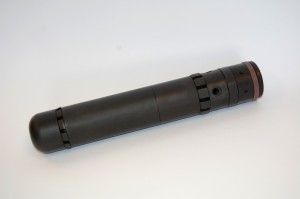Mechanical extrusion process uses robust darts to activate downhole tools
By Katie Mazerov, contributing editor
Aberdeen-based Churchill Drilling Tools has developed a mechanical extrusion process that uses rigid metal darts to improve cycling and to open downhole tools. Appropriate for both land and offshore applications, the technology has been used in more than 200 wells, primarily offshore in North and South America, in addition to Africa and Europe, said co-director Mike Churchill.

Commercially introduced three years ago, the technology replaces the conventional polymer extrusion process that uses steel or nylon balls to activate downhole tools, Mr Churchill explained. In this process, the ball is dropped into a tool and lands on a seat, and continuous pumping pushes the seat down to allow the device to open. After activating the tool, the ball is then pushed or extruded through the seat.
“But there are limitations with this method, because when the ball lands in the seat, there is just one pressure point where it blows through,” Mr Churchill explained. “That means the pressure point needs to be high enough to power the tool to perform all the functions it needs to do but not so high that it can’t be blown out eventually. Balls can blow through prematurely when they are subjected to high-pressure pumping. The mechanical extrusion method solves that delicate balance.”
In comparison, mechanical extrusion has two shear points. The mechanical metal SMART DART is calibrated internally with shear pins so it mimics the effect achieved with a polymer to slip through when pumped with a certain amount of pressure. The dart lands on its shoulder in the tool and pushes down like a ball. “But because the dart is very robust, it can be pumped aggressively to open the tool without shearing prematurely,” he explained. When the task is finished, a closing device is pumped downhole, hits a button on the top of the dart and shears it. “The dart remains hard when it needs to be tough but becomes soft so it can be pushed through when the work is finished.”
HPHT, high-angle applications
The technology has been implemented with valves and for pressure testing, but the company believes the method can be used to set almost any downhole device, such as reamers or packers. The metal dart can be rated up to 660°F and 20,000 psi, making it well suited for high-pressure, high-temperature (HPHT) environments. The technology has also been used in high-angle wells, where activating devices must be pumped especially hard to overcome gravity.
“If you’re pumping hard with the polymer extrusion process, the ball is much more likely to blow through the tool you are trying to activate because it is traveling at such a high speed,” Mr Churchill continued. “The greater power of the mechanical extrusion ensures that the device will not go through the tool prematurely and will enable all the necessary functions. And because the device is less likely to blow through the tool accidentally, the operators don’t need to be so cautious about how the device is delivered into the tool.”
The mechanical extrusion darts are provided in different profiles to deploy tool configurations according to application. “This means a single tool downhole can have multiple configuration options, which are determined simply by the profile of the dart that is dropped,” he said.
SMART DART is a trademarked term of Churchill Drilling Tools.




